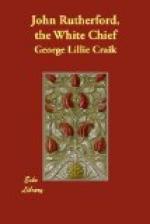FOOTNOTES:
[Footnote AL: The hakari, or feast, a great function in former times.]
[Footnote AM: This name is spelt wrongly. It might be Te Pahi, a famous chief, but it is reported that he died soon after the affair of the “Boyd,” in 1809, some time before Rutherford’s arrival in New Zealand. The tribe, however, may still have been known as Te Pahi’s.]
[Footnote AN: Whangaroa.]
CHAPTER VI.
The native land animals of New Zealand are not numerous. The most common is said to be one resembling our fox-dog, which is sometimes eaten for food. It runs wild in the woods, and is described by Savage as usually of a black and white skin, with pricked up ears, and the hair rather long. But it may perhaps be doubted if even this quadruped is a native of the country.[AO]
According to Rutherford the pigs run wild in the woods, and are hunted by dogs. He also mentions that there are a few horned cattle in the interior, which have been bred from some left by the discovery ships. No other account, however, confirms this statement. There are in New Zealand a few rats, and bats; and the coasts are frequented by seals of different species. One of the natives told Cook that there was in the interior a lizard eight feet long, and as thick as a man’s body, which burrowed in the ground, and sometimes seized and devoured men. This animal, of the existence of which we have the additional evidence of an exactly similar description given by one of the chiefs to Nicholas, is probably an alligator. The natives, as we learn from Cruise, have the greatest horror of a lizard, in the shape of which animal they believe it is that the atua (or demon) is wont to take possession of the dying, and to devour their entrails—a superstition which may not be unconnected with the dread the alligator has spread among them by its actual ravages, or the stories that have been propagated respecting it. They report that in the part of the country where it is found it makes great havoc among children, carrying them off and devouring them whenever they come in its way.[AP]
There are not many species of insects, those seen by Anderson, who accompanied Cook, being only a few dragonflies, butterflies, grasshoppers, spiders, and black ants, vast numbers of scorpion flies, and a sandfly, which is described as the only noxious insect in the country. It insinuates itself under the foot, and bites like a mosquito.
The birds of New Zealand are very numerous, and almost all are peculiar to the country. Among them are wild ducks, large wood-pigeons, seagulls, rails, parrots, and parrakeets. They are generally very tame.




